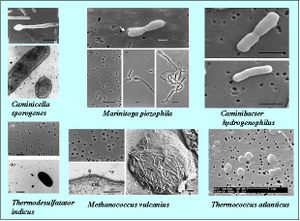Eugena mutabilis
Classification
Eukaryota/Excavata/Discoba;Euglenozoa; Euglenoidea; Euglenales; Euglenaceae; Euglena mutabilis [Others may be used. Use NCBI link to find]
Euglena mutabilis
Description and Significance
Euglena is a genus of unicellular flagellate protists. Species of Euglena are typically found in fresh and salt waters. They are often abundant in inland waters, where they may grow in enough numbers to color the surface of ponds and ditches green, for example E. viridis or even red, such as E. sanguinea [1].
Most species of Euglena have photosynthesizing chloroplasts within the body of the cell, which enable them to feed by autotrophy. However, they can also take nourishment heterotrophically [2]. Euglena mutabilis,is a protozoan which has the remarkable ability of being able to survive in the toxic waters of the Berkeley Pit by changing its local environment to something more suitable. By means of photosynthesis, it increases the oxygen level in the water, which causes dissolved metals to oxidize and precipitate out. Furthermore, it pulls iron out of the water and channels it inside of itself, thus, an extremophile. E. Mutabilis, for one, tends to grow in clumps, and these clumps clean up their surroundings enough for other extremophiles to move live in. These organisms would collect the metals within their own cells, and upon dying they would sink to the bottom and drag the metals with them [3].
Structure, Metabolism, and Life Cycle
When feeding heterotrophically, the Euglena surrounds a particle of food and consumes it by phagocytosis. When there is enough sunlight for it to feed by phototrophy (autotrophy), it uses chloroplasts containing the pigments Chlorophyll a and Chlorophyll b to produce sugars via photosynthesis [2]. Euglena's chloroplasts are surrounded by three membranes. Euglena chloroplasts contain pyrenoids, used in the synthesis of paramylon, a form of starch energy storage. This enables Euglena to survive in periods of light deprivation. The presence of pyrenoids is used as an identifying feature of the genus, separating it from other Euglenoids, such as Lepocinclis and Phacus. All Euglenoids have two flagella rooted in basal bodies located in a small reservoir at the front of the cell. In Euglena, one flagellum is very short, and does not stick out from the cell, while the other is relatively long, and often visible with light microscopy. The longer, emergent flagellum is used to help the organism swim [4]. Like other Euglenoids, Euglena possess a red eyespot, which is an organelle composed of carotenoid pigment granules. The red spot filters the sunlight that falls on a light-detecting structure at the base of the flagellum, allowing only certain wavelengths of light to reach it. As the cell rotates with respect to the light source, the eyespot partially blocks the source, permitting the Euglena to find the light and move toward it. This process is known as phototaxis.[4] Euglena lacks a cell wall and instead has a pellicle made up of a protein layer supported by a substructure of microtubules, arranged in strips spiraling around the cell. The action of these pellicle strips sliding over one another gives Euglena flexibility and the ability to contract.[5] In low moisture conditions and/or when food is scarce, Euglena forms a protective wall around itself and lying dormant as a resting cyst until environmental conditions improve [5].
Reproduction Euglena reproduce asexually through binary fission, a form of cell division. Reproduction begins with the mitosis of the cell nucleus, followed by the division of the cell itself. Euglena divide longitudinally, beginning at the front end of the cell, with the duplication of flagellar processes, gullet and stigma.[6]
Ecology
As stated before species of Euglena are found in fresh and salt waters. They are often abundant in quiet, inland waters.
References
[1] Wolosski, Konrad. "Phylum Euglenophyta". In John, David M.; Whitton, Brian A.; Brook, Alan J. The Freshwater Algal Flora of the British Isles: an Identification Guide to Freshwater and Terrestrial Algae. p. 144. ISBN 978-0-521-77051-4. [2] Nisbet, Brenda (1984). Nutrition and Feeding Strategies in Protozoa. p. 73. ISBN 0-7099-1800-3. [3] Solensky, Richard. "The Pit of Life and Death." • Damn Interesting. N.p., 1 July 2008. Web. 21 July 2013. [4] Marin, B; Palm, A; Klingberg, M; Melkonian, M (2003). "Phylogeny and taxonomic revision of plastid-containing euglenophytes based on SSU rDNA sequence comparisons and synapomorphic signatures in the SSU rRNA secondary structure". Protist 154 (1): 99–145. doi:10.1078/143446103764928521. PMID 12812373 [5] Schaechter, Moselio (2011). Eukaryotic Microbes. San Diego: Elsevier/Academic Press. p. 315. ISBN 978-0-12-383876-6. [6] Gojdics, Mary (1934). "The Cell Morphology and Division of Euglena deses Ehrbg". Transactions of the American Microscopical Society 53 (4): 299–310. doi:10.2307/3222381. JSTOR 3222381
Author
Page authored by McKale Lee, student of Mandy Brosnahan, Instructor at the University of Minnesota-Twin Cities, MICB 3301/3303: Biology of Microorganisms.

